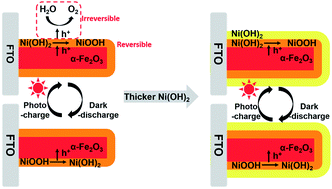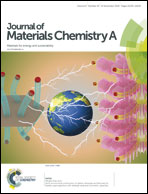Direct storage of holes in ultrathin Ni(OH)2 on Fe2O3 photoelectrodes for integrated solar charging battery-type supercapacitors†
Abstract
Energy storage is a very significant issue for utilization of solar energy due to its discontinuous and unstable energy flux. Herein, for the first time, we propose a Fe2O3@Ni(OH)2 core–shell nanorod array as a photoelectrochemical battery-type supercapacitor for the direct storage of solar energy. Under light illumination, Fe2O3 absorbs solar energy and produces electron–hole pairs, while Ni(OH)2 stores the photo-generated holes, which can be released as electricity when the light is switched off. In addition, by controlling the valence band position of the semiconductor and the thickness of Ni(OH)2, the side reaction of water oxidation (electrolyte decomposition), which is harmful for the applications of a photoelectrochemical supercapacitor, can be completely suppressed. As a consequence, the specific capacitance of the Fe2O3@Ni(OH)2 photoelectrochemical supercapacitor is enhanced up to 20.6 mF cm−2 at a discharge current density of 0.1 mA cm−2, which is about 4.5 times that of BiVO4/PbOx reported in a previous study. This study offers a very promising device for the direct storage of solar energy and deepens our understanding on the interface charge transfer between a photoelectrode and a battery-type capacitive material.



 Please wait while we load your content...
Please wait while we load your content...